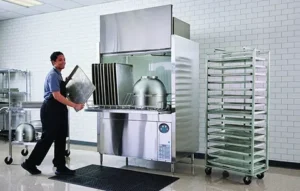Proper ventilation is essential for maintaining a healthy and comfortable indoor environment. Allowing fresh air to circulate and expel stale air helps control indoor air quality and reduces the risk of respiratory issues. Good Ventilation Installation also helps regulate humidity levels, preventing the growth of mould and mildew, which can damage the property and affect occupants’ health. Also, proper ventilation helps remove indoor pollutants, such as carbon dioxide and volatile organic compounds, improving overall air quality.
Different Types of Ventilation Systems and Their Uses
Ventilation systems are designed to meet varying needs and conditions. Natural ventilation relies on windows, doors, and vents to facilitate airflow, making it suitable for areas with milder climates. Mechanical ventilation encompasses a range of systems, including exhaust and supply systems, that use fans and ducts to control air movement.
Natural Ventilation for Sustainable Airflow
Natural ventilation utilises openings such as windows, doors, and vents to promote fresh air circulation. This method is energy-efficient and works best in regions with mild weather conditions.
Mechanical Ventilation for Controlled Air Quality
Mechanical systems, including exhaust and supply fans, regulate airflow to maintain indoor air quality. These systems are essential in spaces requiring insufficient natural ventilation or air purification.
Combining Natural and Mechanical Methods
Mixed-mode ventilation integrates natural and mechanical strategies, adjusting airflow based on environmental conditions. This hybrid approach optimises efficiency while maintaining consistent air quality.
Choosing the Right Ventilation System
Selecting a ventilation system depends on climate, building layout, and air quality requirements. The right choice enhances comfort while ensuring proper airflow management.
Enhancing Indoor Comfort with Proper Ventilation
Well-ventilated spaces improve occupant health by reducing humidity, allergens, and airborne pollutants. A properly installed ventilation system ensures fresh air circulation, creating a comfortable and healthy indoor environment.
Evaluating the Size and Layout of Your Property
The size and layout of your property heavily influence the design and effectiveness of a ventilation system. Larger properties often require more advanced systems to ensure even airflow distribution and efficient reach in all areas. The configuration, including the number of floors and the spatial arrangement of rooms, dictates how air circulates and where vents and ducts should be placed for optimal performance.
For multi-storey homes, it’s essential to ensure that upper floors receive as much fresh air as lower ones, which may involve using additional or more powerful fans and ducts. Any partitioned areas, like attics and basements, should also be considered, as they may require independent ventilation solutions to avoid stagnant air pockets. Properly planned layouts help prevent issues such as uneven temperature distribution and poor air quality in certain rooms.
When planning your system, consider how you use different spaces; high-traffic areas or rooms with higher moisture levels may need more targeted ventilation solutions. Working with a professional can help you map out a system that suits your property’s specific dimensions and layout, ensuring comprehensive and efficient air circulation throughout.
Energy Efficiency and Environmental Impact of Ventilation
Modern ventilation technology offers energy-efficient options that can significantly reduce utility costs. Heat recovery ventilation systems, for instance, conserve energy by recycling heat from outgoing air to warm incoming air. These systems lower energy bills and minimise the environmental footprint by reducing the demand for heating and cooling, contributing to a more sustainable property.
The choice of materials and components in your ventilation system also plays a crucial role in its environmental impact. Opting for high-quality, durable materials can enhance the system’s longevity, reducing the need for frequent replacements and thus conserving resources. Additionally, integrating smart controls and sensors allows for more precise airflow management, optimising ventilation according to occupancy and usage patterns. This reduces unnecessary energy consumption and enhances overall efficiency.
Regular maintenance and timely upgrades to more efficient components can improve the system’s performance and energy savings. By focusing on energy efficiency and environmentally friendly practices, property owners can enjoy both financial and ecological benefits, making their homes or buildings more sustainable in the long run.
Cost Implications of Ventilation and Maintenance
The financial aspect of ventilation involves several components beyond the initial purchase and setup. The complexity and scale of the system significantly impact the upfront expenditure. Advanced systems with features like heat recovery or integrated smart controls tend to be more costly initially but can offer long-term savings. Maintenance is another crucial factor; regular upkeep, such as filter changes, cleaning ducts, and inspecting fans, ensures the system operates efficiently and prolongs its lifespan. Neglecting maintenance can lead to higher repair costs due to wear and tear or unexpected malfunctions.
Additionally, the cost of operating the system, including energy consumption, should be considered. Energy-efficient models might have higher initial costs but offer reduced operating expenses, balancing out over time. Hidden expenses, such as upgrading electrical systems to support new installations, can also arise.
Budgeting for periodic professional inspections is advisable to identify and address minor issues before they escalate. Finally, geographical location can influence costs; areas with higher labour rates or stricter building codes might see increased installation and maintenance expenses. Considering these financial elements, you can better plan and manage the overall investment in your property’s ventilation system.
Choosing the Right Professional for Your Ventilation Needs
When selecting a professional for your ventilation project, it’s essential to prioritise those with specialised knowledge and extensive experience in the field. Begin by verifying their credentials and ensuring they hold relevant certifications and licences. These qualifications indicate a thorough understanding of industry standards and best practices.
Request detailed proposals from multiple candidates to compare their approaches, costs, and timelines. Please pay attention to their recommendations, as knowledgeable professionals will provide insights into the most effective and efficient solutions tailored to your property’s needs. Reviewing testimonials and case studies of their past projects is beneficial to gauge their track record.
A reliable installer should conduct a comprehensive site assessment, considering property size, layout, and existing systems. They should also be able to clearly explain the installation process, maintenance requirements, and expected outcomes.
Additionally, consider the level of post-installation support they offer, including warranties and maintenance services. Engaging a professional who provides ongoing support can be invaluable for the longevity and performance of your ventilation system. Transparent communication and a proactive approach to problem-solving are also key indicators of a competent and trustworthy installer.
Key Considerations for Installing an Exhaust Ventilation System
Selecting the right ventilation system is crucial for managing humidity, odours, and air quality, particularly in kitchens and bathrooms. The system’s effectiveness depends on fan capacity, duct design, and vent placement.
The correct fan size is essential to maintaining balanced air pressure. A system that is too small may struggle to remove moisture and pollutants efficiently, while an oversized system can create unnecessary energy consumption and noise. Additionally, strategic vent placement enhances airflow and ensures contaminants are effectively extracted before they spread throughout the space.
Sealing ductwork properly is another critical consideration, as leaks can reduce efficiency and lead to energy waste. Well-sealed ducts ensure all extracted air is directed outside, preventing the recirculation of unwanted humidity and odours.
The noise level of the exhaust fan is also important, particularly in residential settings. Choosing a model with low decibel ratings can enhance comfort without sacrificing performance.
The exhaust system should be integrated with Exhaust Ventilation System for optimal air exchange to maintain a well-balanced indoor environment. This prevents negative pressure issues, which can draw in pollutants from other areas of the home.
Finally, regular maintenance, including cleaning ducts and inspecting fans, is key to long-term efficiency. A well-maintained exhaust system not only improves air quality but also prolongs the lifespan of the equipment, contributing to a healthier and more comfortable indoor space.
Conclusion
Choosing an appropriate Ventilation Installation system requires a holistic approach, considering the property’s size, layout, and specific usage patterns. Integrating energy-efficient technologies can result in significant cost savings and a reduced environmental footprint. Collaborating with a skilled professional ensures the system is tailored to meet your property’s unique demands, enhancing both comfort and air quality. Regular maintenance is crucial for optimal performance and longevity, making it essential to budget for ongoing upkeep and potential upgrades. Investing in high-quality materials and components contributes to a more sustainable and efficient system.
FAQS
What types of ventilation systems are available?
Natural, mechanical, and mixed-mode ventilation systems are suited for different needs and environments. Natural ventilation uses windows and vents, mechanical systems include fans and ducts, and mixed-mode combines both approaches.
Why is exhaust Ventilation Installation important?
Exhaust Ventilation Installation removes moisture and odours from spaces like kitchens and bathrooms. This prevents mould growth and dampness, which can lead to property damage and health issues.
How does property size affect ventilation system choice?
Larger properties often necessitate more robust systems to ensure even airflow throughout. Multi-storey homes and properties with complex layouts may require additional or more powerful ventilation solutions.
What are the benefits of energy-efficient ventilation?
Energy-efficient systems reduce utility costs by conserving the energy used for heating and cooling. These systems also contribute to a reduced environmental footprint, making properties more sustainable.
How can I find a reputable ventilation installer?
Look for certified professionals with positive reviews and experience in the field. Request references and review past project case studies to ensure quality service and effective installation.
| Related Business Listings |
| Contact Directory |
| Local Business Profiles |



